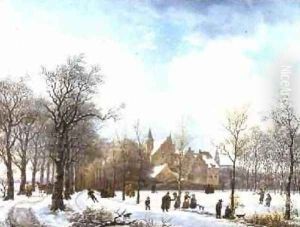Anthony Jacob Offermans Paintings
Anthony Jacob Offermans was a Dutch painter and art collector who lived during the 19th century. Born on October 3, 1809, in The Hague, Netherlands, Offermans was known for his work in various genres, including portraits, landscape paintings, and genre scenes that often depicted everyday life with a keen eye for detail and atmosphere.
Offermans received his early training in the arts at the Drawing Academy in The Hague, where he was exposed to the works of prominent Dutch artists of the time. He was particularly influenced by the Dutch Golden Age painters, whose techniques and attention to light he sought to emulate in his own work. He later continued his studies in Paris, which was then the center of the art world, and was influenced by the French Romantic painters.
During his career, Offermans developed a style that reflected both the Dutch tradition and the influence of his contemporaries. His portraits were appreciated for their realism and psychological depth. He had a talent for capturing the character and social standing of his subjects, often members of the Dutch bourgeoisie.
Apart from painting, Offermans was also a passionate art collector, and he amassed a significant collection of artworks including paintings, drawings, and prints. His collection included both Old Masters and contemporary works, which reflected his broad taste and interest in art.
Anthony Jacob Offermans' contributions to the Dutch art scene were recognized by his contemporaries, and his works were exhibited in various salons and exhibitions. Despite this, he did not gain widespread fame during his lifetime, and his work was mostly appreciated by connoisseurs and collectors.
Offermans died on December 11, 1864, in his hometown of The Hague. Today, his paintings can be found in the collections of several Dutch museums, and his work is studied by those interested in 19th-century Dutch art. Offermans remains a respected figure in the history of Dutch painting, particularly for his dedication to the craft and his ability to capture the essence of his subjects with authenticity and care.
